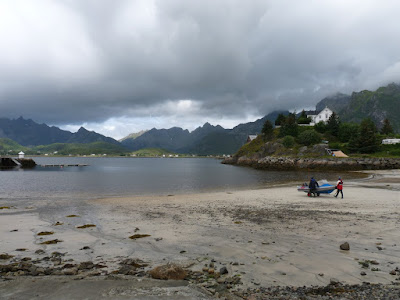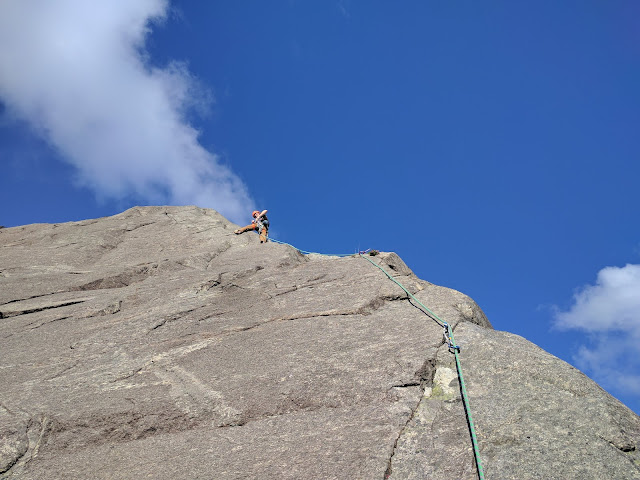Something about Lofoten
I'm not going to be able to do anything if I try to stick to a strictly chronological order of climbs-with-photos-and-memories. Even thought they're digital records, most of my photos are scattered across multiple old phones and memory cards, hard-drives, old flickr accounts, emails to people – there's no such thing as a search function for dredging through the multiple platforms that we've spread ourselves out on.
In July 2013 me and the Bomb went to Lofoten, the arched-bushy-eyebrow-shaped line of mountains that make a dotted line out of the coast of the North of Norway. We flew from Bergen to the Harstad/Narvik Evenes airport, hired a car and drove West. The week was so completely wet that we camped several nights before we could see any mountains; there's a running-joke in Asterix in Switzerland that because Asterix and Obelix are mostly moving around Geneva under cover of darkness, Obelix forms the belief that Switzerland is entirely flat. We could have been given that impression if the clouds hadn't lifted for a couple of days.
On the first occasion there was sun we were right next to the area climbers call Paradiset, so we decided to go there to warm up and get used to the rock. It was swarming with frustrated climbers who were happy to get out of their tents and take their tops off. I'd planned to get on 'By The Dashboard Light', a three-star 35 metre slab and corner climb that gets graded n4. It's been renamed 'Storsvaet' by Rockfax because the geniuses there couldn't ask around and find the name the first ascensionists gave it. Stor is Norwegian for 'big', and sva is Norwegian for slab, so 'Storsvaet' goes to great heights as an imaginative baptism. [The original name riffs on the fact that the area is called 'Paradise' – Meatloaf has a famous track titled 'Paradise by the dashboard lights'].
The climb starts on a wide shelf just above the sea, I can't remember if it's tidal, but the rock was a lovely warm red granite, it hadn't been polished by pebbles, it was rough, great friction. A low-angled bulging apron-like slab gradually steepens into a respectable off-vertical angle and the route makes a backwards-J curve across it. At 2/3rds height it joins a large overlapping block on the left, and the route continues up the right-angled corner and mounts this block. The first section is hard to protect – it's a typical slab climb, careful foot placements on a line of indentations on an uncracked and solid lump of rock – but there's big placements in the cracked corner. After surmounting the block you step back on to the main slab/wall, where the angle has lessened again, and pad up the slab following a seam of shallow, flared pockets to the top. In UK grades it's probably Severe, maybe HS because of the run-out nature, I think I placed three or perhaps four (max) pieces of protection over 35 m. Definitely a three-star experience – the corner crack can be laybacked in a very satisfactory style, and the Bomb launched herself into a layback without thinking twice, never having done it before.
The only other dry day was used for hiking, we got overland to a secluded beach. This year a new edition of the Lofoten guide book has been published, but I don't feel like I've had a real chance to get proper use out of the earlier one – there's definitely a lot of unfinished business here.
In July 2013 me and the Bomb went to Lofoten, the arched-bushy-eyebrow-shaped line of mountains that make a dotted line out of the coast of the North of Norway. We flew from Bergen to the Harstad/Narvik Evenes airport, hired a car and drove West. The week was so completely wet that we camped several nights before we could see any mountains; there's a running-joke in Asterix in Switzerland that because Asterix and Obelix are mostly moving around Geneva under cover of darkness, Obelix forms the belief that Switzerland is entirely flat. We could have been given that impression if the clouds hadn't lifted for a couple of days.
 |
| Our first view of anything. |
On the first occasion there was sun we were right next to the area climbers call Paradiset, so we decided to go there to warm up and get used to the rock. It was swarming with frustrated climbers who were happy to get out of their tents and take their tops off. I'd planned to get on 'By The Dashboard Light', a three-star 35 metre slab and corner climb that gets graded n4. It's been renamed 'Storsvaet' by Rockfax because the geniuses there couldn't ask around and find the name the first ascensionists gave it. Stor is Norwegian for 'big', and sva is Norwegian for slab, so 'Storsvaet' goes to great heights as an imaginative baptism. [The original name riffs on the fact that the area is called 'Paradise' – Meatloaf has a famous track titled 'Paradise by the dashboard lights'].
The climb starts on a wide shelf just above the sea, I can't remember if it's tidal, but the rock was a lovely warm red granite, it hadn't been polished by pebbles, it was rough, great friction. A low-angled bulging apron-like slab gradually steepens into a respectable off-vertical angle and the route makes a backwards-J curve across it. At 2/3rds height it joins a large overlapping block on the left, and the route continues up the right-angled corner and mounts this block. The first section is hard to protect – it's a typical slab climb, careful foot placements on a line of indentations on an uncracked and solid lump of rock – but there's big placements in the cracked corner. After surmounting the block you step back on to the main slab/wall, where the angle has lessened again, and pad up the slab following a seam of shallow, flared pockets to the top. In UK grades it's probably Severe, maybe HS because of the run-out nature, I think I placed three or perhaps four (max) pieces of protection over 35 m. Definitely a three-star experience – the corner crack can be laybacked in a very satisfactory style, and the Bomb launched herself into a layback without thinking twice, never having done it before.
 |
| Gesturing towards nothing in particular. |


Comments
Post a Comment